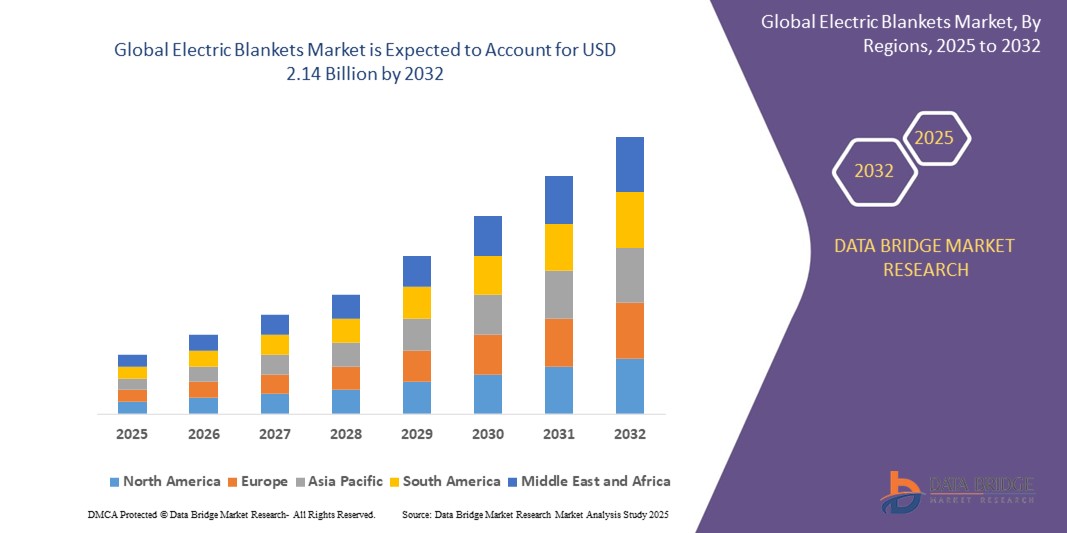The global Electric Blankets Market is witnessing steady growth, driven by rising consumer demand for energy-efficient heating solutions, increasing awareness about thermal comfort, and technological advancements that enhance safety and usability. As extreme weather conditions become more frequent and household energy-efficient appliances gain popularity, electric blankets have emerged as a practical, cost-effective alternative to traditional space heaters. This article provides a detailed analysis of the market, including key drivers, challenges, product innovations, regional trends, and future opportunities.
Market Overview
Electric blankets are bedding accessories integrated with insulated heating wires and temperature control systems that deliver controlled warmth. They are widely used in homes, hospitals, eldercare facilities, and even during outdoor recreational activities. Over the last decade, advancements in heating technologies, smart connectivity, and safety features have broadened the market’s appeal and expanded its applications.
The market is expected to grow at a notable pace due to the increasing prevalence of cold climatic conditions in North America, Europe, and parts of Asia-Pacific. Furthermore, rising disposable incomes, urbanization, and changing consumer lifestyles are contributing to the rapid adoption of electric heating products, including heated blankets, throws, and mattress pads.
Market Drivers
1. Rising Demand for Energy-Efficient Heating Solutions
As energy prices continue to rise globally, consumers are seeking affordable alternatives to whole-room heating. Electric blankets consume significantly less electricity compared to centralized heating systems and portable space heaters. They allow users to warm up their beds or personal spaces quickly and efficiently without heating entire rooms, resulting in substantial energy savings.
2. Increasing Adoption in Cold Regions
Countries with prolonged cold seasons, including Canada, the United States, Nordic countries, Russia, Germany, Japan, and South Korea, show high adoption rates. With winters becoming increasingly unpredictable and often harsher due to climate change, households prioritize reliable and controllable heating solutions such as electric blankets.
3. Technological Advancements and Smart Features
Today’s electric blankets offer far more than just basic heating functions. Innovations include:
-
Programmable timers
-
Dual temperature controls
-
Overheat protection
-
Smartphone app connectivity
-
Automatic shut-off
-
Advanced insulation materials
These features improve user convenience and safety, making electric blankets more appealing to modern consumers.
4. Growing Usage in Healthcare and Elderly Care
Electric blankets play a crucial role in providing warmth and comfort to elderly people, patients recovering from surgery, and individuals suffering from conditions like arthritis, poor circulation, or chronic cold sensitivity. Hospitals and home-care centers increasingly rely on heating blankets to maintain body temperature, especially during long procedures or in post-operative recovery.
Market Challenges
1. Safety Concerns and Product Recalls
Incidents involving short circuits, overheating, and fire hazards pose significant concerns. While modern blankets are generally safe, older models or low-quality imports may present risks. Ensuring compliance with strict safety standards is essential for manufacturers.
2. Limited Awareness in Developing Economies
In many developing countries, consumers are still unfamiliar with the benefits and uses of electric blankets. Lack of awareness, limited product availability, and the perception of high prices hinder adoption.
3. Seasonal Demand Fluctuations
Demand for electric blankets heavily depends on seasonal weather trends. Warmer-than-usual winters can lead to reduced sales, affecting revenue stability for manufacturers.
Market Segmentation
By Product Type
-
Electric Underblankets: Placed beneath the bedsheet, ideal for pre-heating beds.
-
Electric Overblankets: Used on top of the user for direct warmth.
-
Electric Throws: Lightweight, portable blankets commonly used in living spaces.
-
Electric Heating Pads: Mainly used in healthcare for pain relief and physiotherapy.
By Material
-
Polyester
-
Fleece
-
Cotton
-
Wool
-
Micro plush fabrics
By Distribution Channel
-
Supermarkets/Hypermarkets
-
Specialty Home Stores
-
Online Retail (Amazon, official brand websites, etc.)
-
Department Stores
By End Use
-
Residential
-
Commercial (hotels, hospitals, elderly care homes)
Regional Analysis
North America
One of the largest markets due to long winters, high technological adoption, and the presence of major manufacturers. The United States dominates the region, supported by growing e-commerce channels.
Europe
Countries like the U.K., Germany, France, and the Nordic nations experience heavy demand. Strict safety regulations also push manufacturers to develop high-quality products.
Asia-Pacific
Japan, South Korea, and China represent rapidly growing markets. Rising disposable incomes and exposure to advanced home-comfort appliances are boosting sales. In India, cold-weather states such as Himachal Pradesh and Kashmir show growing interest.
Latin America & Middle East
These regions exhibit moderate demand. However, increasing urbanization and consumer spending are expected to create new opportunities.
Competitive Landscape
The electric blankets market features strong competition from established brands and new entrants focusing on innovation and price competitiveness. Key players often invest in:
-
R&D for enhanced safety technologies
-
Durable and eco-friendly materials
-
Smart home integration
-
Attractive designs and lightweight models
Popular brands include Sunbeam, Biddeford, Beurer, Morphy Richards, Bedsure, and Xiaomi (in Asia).
Future Outlook
The global electric blankets market is poised for robust expansion over the next decade. Key future trends include:
1. Integration with Smart Home Ecosystems
More consumers will be able to control their blankets using voice assistants like Alexa and Google Assistant, temperature sensors, and home automation systems.
2. Growing Popularity of Battery-Powered Blankets
Rechargeable and portable electric blankets are gaining popularity for outdoor activities, vehicles, and camping.
3. Eco-Friendly and Sustainable Materials
Manufacturers are expected to introduce organic textiles, recycled fibers, and greener production methods.
4. Expansion in Emerging Markets
As awareness increases and prices become more competitive, developing economies will present major growth opportunities.
Get More Details:
https://www.databridgemarketresearch.com/reports/global-electric-blankets-market
Conclusion
The Electric Blankets Market is evolving rapidly, driven by advancements in heating technology, increasing consumer focus on energy efficiency, and growing demand across residential and healthcare sectors. Although safety concerns and seasonal demand fluctuations pose challenges, continuous innovation and broader market penetration are expected to fuel consistent growth in the years ahead.
Tags: #electricblankets #electricblanketdoublebed #electricblanketsinglebed #electricblanketmeesho #philipselectricblanket #philipselectricblanketprice #electricblanketdoublebedprice #bedwarmerelectric #electricblanketkashmir
